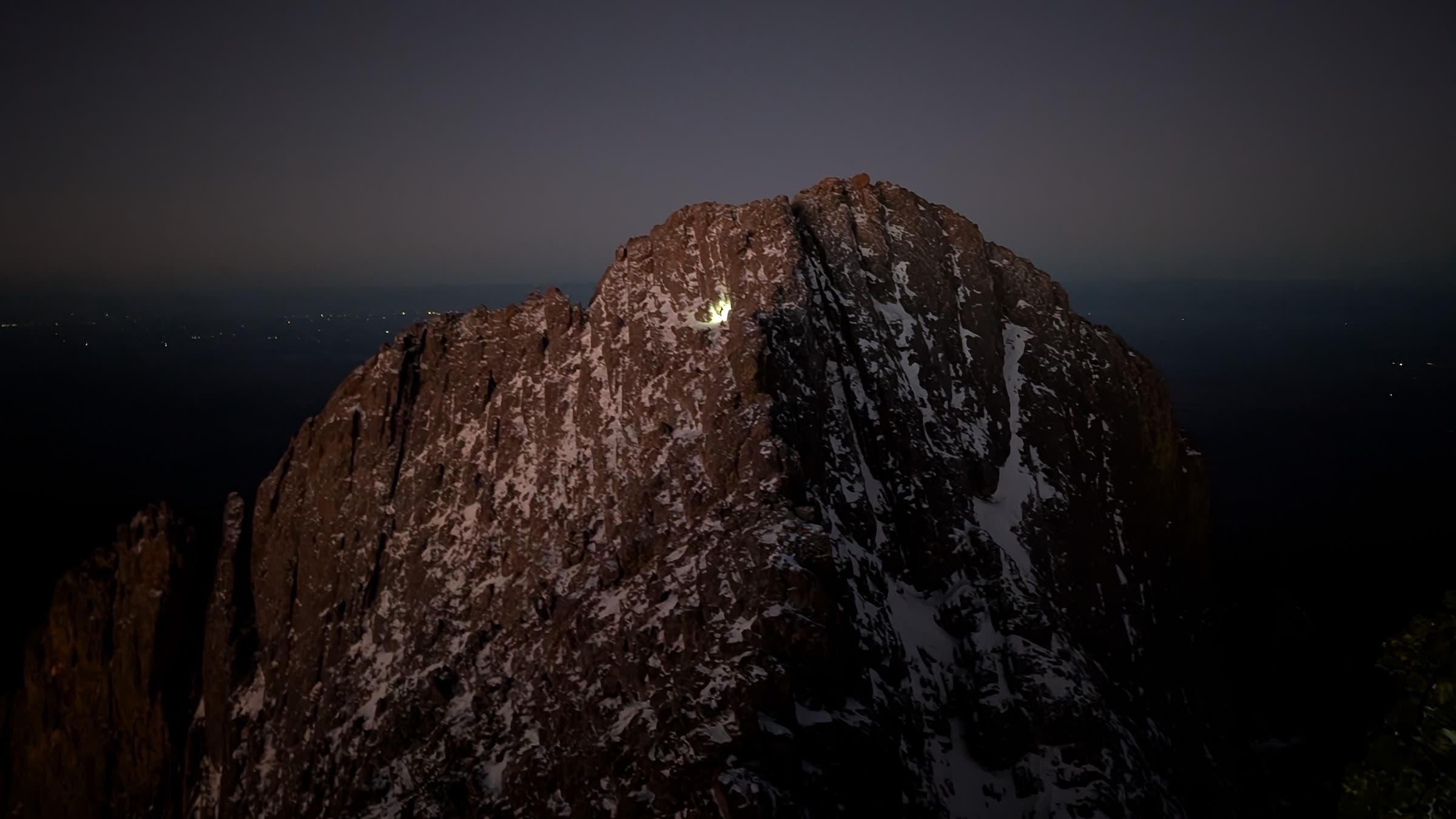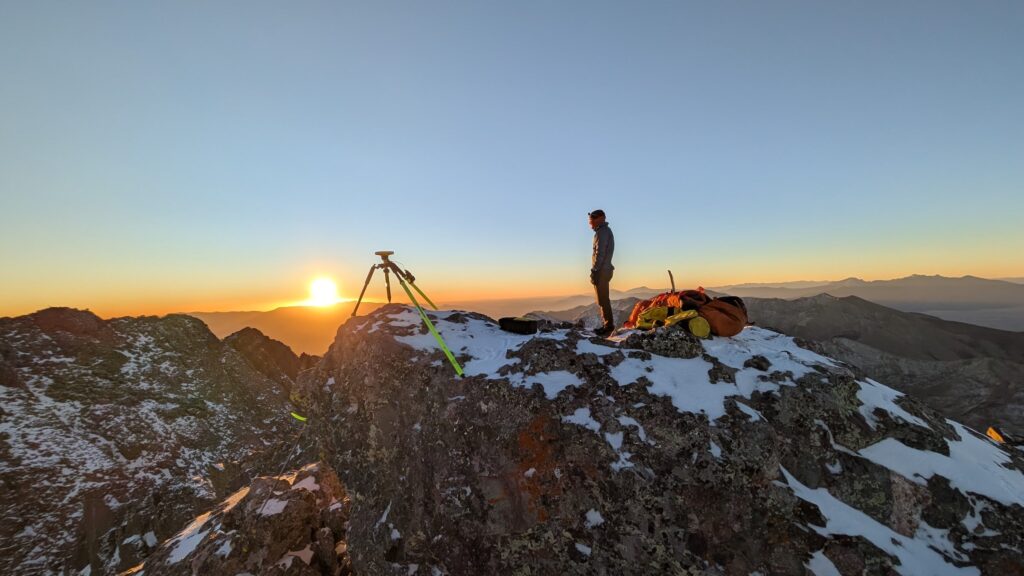Published October 17, 2025 08:59AM
Just after 1:30 A.M. on the morning of October 5, Eric Gilbertson, a professor of mechanical engineering at Seattle University, set out with three friends to hike up Cottonwood Creek Trail, a strenuous approach to Colorado’s Crestone Peak.
The jagged summit of Crestone Peak, Colorado’s seventh-highest mountain, looks like a camel’s back, with two rocky pinnacles jutting skyward from the Sangre de Cristo range. One of these prominences is Crestone Peak, and the other is a sub-summit called East Crestone, which is just 418 feet away.
The men reached the summit of East Crestone right before sunrise. Gilbertson’s goal wasn’t just to climb the mountain, but to use high-tech surveying tools to measure its precise height.
In an interview with Outside, Gilbertson said that his measurements suggest that East Crestone measures 14,299.3 feet high, making it approximately 3.6 inches taller than Crestone Peak, which is 14,299 feet. This measurement, Gilberton says, reverses the conventional belief that East Crestone is the sub-summit of Crestone Peak.
“Thus, East Crestone is now a ranked 14er, and Crestone is a subpeak,” Gilbertson said. “East Crestone should be added to the list of 53 ranked 14ers in Colorado and Crestone Peak removed.”
While this measurement may seem minor, it could have major repercussions for the thousands of hikers who climb the 53 peaks that rise above 14,000 feet in Colorado. For decades, Crestone Peak has been on the 14er list, but East Crestone has not. Gilbertson believes his measurements should change the hierarchy of Crestone summits, and remove one 14er from the list while adding another.
But the official bodies that measure peaks in Colorado have yet to weigh in on his findings.
In Pursuit of Peak Bags and Elevation Measurements
To measure the peaks, Gilbertson and his team used professional surveying equipment to take ground measurements at each summit. They did so by mounting receivers on identical tripods that took simultaneous two-hour, 15-minute survey data. A global navigation system, or GNSS, then determined the distance between these receivers and satellites in space, calculating the receiver’s exact location on Earth.
“We needed to strap a hiking pole on one tripod leg to extend it off the cliffy north face of Crestone to reach rock,” Gilbertson told Outside, adding that data was processed with three different models. “All results were consistent that East Crestone is 0.3 feet taller than Crestone, with greater than 99.9 percent confidence that East Crestone is taller.”
Gilbertson’s method is different from a 2021 mission to measure the mountains, which relied on light detection and ranging (LiDAR) technology. But he believes this measurement was flawed, because it “appeared to pick up a person on the summit of Crestone, giving it an artificially high elevation,” he said. Aerial LiDAR measurements record elevation by pinging pulses of light between a plane and a point on Earth and recording the amount of time it takes for that ping to travel between the two. But because the pulses hit the ground every one to six feet, they can sometimes “miss sharp points in between and under-measure a summit elevation,” which Gilbertson says happened on East Crestone.
A previous U.S. Geological Survey (USGS) measurement of the mountain used a theodolite, a land survey technique that measures horizontal and vertical angles between points. That technique only measured Crestone Peak, and not East Crestone. Other measurements, including those done by photogrammetry and an Abney survey, have also been conducted on Crestone Peak. Gilbertson said that it’s likely these surveys simply missed measuring East Crestone.
“I think it’s unlikely the summits shifted. The simplest explanation is they just hadn’t been measured accurately enough until now to know which was taller,” said Gilbertson.
In an Instagram post, Gilbertson shared photos of the project. His findings were also posted on the website Country High Points, but not yet published in a peer-reviewed scientific journal.
While the data suggests a new peak designation may be in order, the summit has not been officially declared a “new” 14er by the Colorado Geological Survey, the state agency that approves the measurements of geographic features. So, technically, Colorado hasn’t named East Crestone the newest 14er. And experts don’t seem to be in a rush to do so.
No Official Update or Designation Has Yet Been Made
Experts within Colorado’s 14er community aren’t entirely convinced that Gilbertson’s data should cause significant changes.
Lloyd Athearn, executive director of the Colorado Fourteeners Initiative, told Outside that East Crestone is not necessarily a new 14er, but “just where the highest point is on Crestone Peak and what would be considered a subsidiary point.”
“This is an interesting surveying effort, but not one that gives us a new 14er,” said Athearn.
Vince Matthews, a retired director of the Colorado Geological Survey, said that regular refinements in the elevation of Colorado peaks have caused some changes over the years. Matthews said that there is a simmering disagreement about the height of the state’s highest peak, Mount Elbert. Some researchers believe the mountain is 4,438 feet high and not 14,440 feet, which was the elevation determined by a survey in the early 21st century. A prior survey pegged the mountain at 14,443 feet before that. In the early 1870s, Elbert’s elevation was measured to be 14,351 feet, Matthews said.
“Moreover, the federal agencies currently have a project at Mount Elbert to use the best, most up-to-date instruments, models, and analytic techniques to determine a precise elevation for its highest point,” said Matthews, adding that these results will be used throughout the U.S. to revise elevation datasets.
But to get on the Colorado Geological Survey’s official list, the peak must have gone through the USGS naming procedures and reside in the Geographic Names Information System.
Matthews also told Outside that whether the latest recorded height of East Crestone would add it to the list of 14ers “depends on whom you ask.” He pointed out that multiple peaks rise above 14,000 feet in the so-called Crestone Cluster, a collection of pinnacles that includes Crestone Peak, including the 14,195-foot Crestone Needle, 14,165-foot Kit Carson Peak, and 14,070-foot Humboldt Peak.
“All of the ‘peaks’ in the Crestone Cluster exceed 14,000 feet in elevation,” Matthews said.
Other mountains in Colorado have multiple pinnacles that rise above 14,000 feet, but climbers agree that they are all part of the same mountain. “For instance, Mount Massive has about seven discrete, little topographic peaks, but only the highest is named,” Matthews added.

Federal Agencies are Responsible for Designating Features
The USGS is responsible for naming and mapping geographic features in the country, while NOAA’s National Geodetic Survey (NGS) does the job of measuring them.
Matthews sent Outside the “best, most up-to-date” list of summits above 14,000 feet compiled by the Colorado Geological Survey, according to information from the USGS and NGS. In it, there are 58 named peaks in Colorado exceeding 14,000 feet, many of which are cross-checked against USGS topographic maps and NGS satellite data.
The Colorado Mountain Club ultimately declares what is and is not a 14er to serve as a guide to peak baggers, says Matthews.
The discrepancy between the 58 named peaks and 53 14ers is due to the “14er rule” that the Colorado 14ers group follows. For a peak to qualify as a bona fide 14er, there must be at least a 300-foot drop in elevation between it and an adjacent peak above 14,000 feet. That’s why multiple high points on a ridge, for example, don’t count as individual 14ers.
“I suggest that the measuring and naming of peaks be left to the federal agencies responsible for those matters,” Matthews said.
In other words, if East Crestone is to someday replace Crestone Peak as a 14er, more rigorous, peer-reviewed research is needed to confirm Gilbertson’s findings. Having surveyed over 60 peaks around the world and climbed the highest peak in 147 countries, Gilbertson now plans to submit his findings to a scientific journal.
If East Crestone is to someday replace Crestone Peak as a 14er, Gilbertson doesn’t believe that the thousands of hikers to have ascended 53 14ers should have to go back and re-climb East Crestone.
“We would propose that anyone who has already completed the 14ers or another list, including Crestone, is grandfathered in and still considered a finisher. Moving forward, climbers should climb East Crestone to complete the ranked 14ers list and centennials list,” he said.


